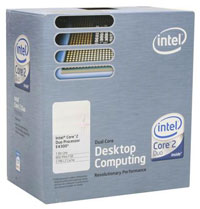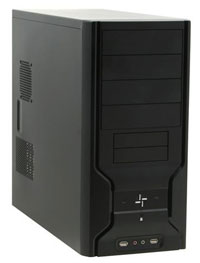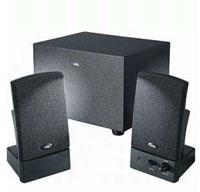Entry Level Intel
Our entry level Intel configuration contains many of the same components as the AMD configuration. The only actual changes are in the choice of motherboard and processor. However, trying to make the systems "equivalent" was simply not realistic. We could either cut the costs of the processor dramatically by going with an older Pentium D offering - not something we would recommend these days - or we end up spending more due to higher prices of Core 2 Duo parts. Intel should be releasing some additional budget offerings in the future, including some single core chips that use the Core architecture. Regardless, if you're looking at Intel-based computers these days we would invariably opt to spend the money and get a Core 2 Duo.
| Intel Entry Level System |
| Hardware |
Component |
Price |
Rebates |
| Processor |
Intel Core 2 Duo E4300 (1.80GHz 2MB Shared) - Retail |
$135 |
|
| Motherboard |
MSI G965M-FI (LGA 775 965G) |
$90 |
|
| Memory |
WINTEC AMPO 2x512MB DDR2-800 (5-5-5-12 3AMD2800-1G1K-R) |
$65 |
|
| Hard Drive |
Western Digital Caviar SE16 WD2500KS 250GB 16MB |
$70 |
|
| Optical Drive |
Lite-On 20X DVD+R LH-20A1P-185 |
$34 |
|
| Case |
RAIDMAX APEX ATX-802BP with 450W PSU |
$65 |
|
| Display |
Hanns-G JC-199DPB 19" 8ms (1280x1024) |
$184 |
$40 |
| Speakers |
Cyber Acoustics CA3001WB 14 watts 2.1 Speakers |
$24 |
|
| Keyboard and Mouse |
Microsoft Comfort Curve 2000 B2L-00047 |
$28 |
|
| Operating System |
Windows MCE 2005 or Vista Home Premium (OEM) |
$115 |
|
| Bottom Line |
|
$810 |
$770 |
 |
Given that price is a major consideration for any budget computer, there was really only one reasonable choice for the processor given the above statements. The Core 2 Duo E4300 is still more expensive than what we would generally classify as an entry level component, but that doesn't mean it isn't worth the money. In pretty much any benchmark you throw at it, the E4300 is going to end up faster than the Athlon X2 3600+ we used in our AMD configuration. Of course, if you were to go out and purchase a $135 AMD part, the performance advantage will likely swing the other way.
 |
Not only do you have to generally spend more money on the processor for the Core 2 Duo platform, but motherboards also tend to cost more than roughly equal offerings from the AMD camp. Since we're using integrated graphics for our entry level configurations, things get even trickier. The IGP offerings for socket AM2 are at present much better than the IGP offerings for socket 775. They perform better, and perhaps more importantly they do so while costing less money. That's not to say that you can't find inexpensive Core 2 Duo compatible motherboards; there are quite a few VIA chipset solutions. For overall quality and reliability, however, we prefer to avoid those if possible, as they can be a bit quirky at times. Motherboards are simply too critical of a component in our view.
Given the choices, we eventually decided to stick with the standard Intel G965 chipset. Graphics performance is subpar compared to the current AMD and NVIDIA offerings, but even then it's still sufficient for most tasks. Intense 3D gaming is not one of those tasks, and even at low resolutions and low detail settings there are so games that won't work properly on this chipset. The X3000 graphics core is supposed to be much improved over previous Intel solutions, but our own opinion is that it remains a lackluster offering. Outside of gaming, however, there are very few applications that require more graphics processing power.
 |
Looking at the G965 motherboards currently available, even the most basic models start at closer to $90, with some of the better equipped models costing as much as $130. The MSI G965M-FI we selected is one of the least expensive offerings but it still does quite well in the features department. Naturally the motherboard supports all Core 2 Duo processors currently available, though it lacks overclocking support in the BIOS at this time. This MSI board also includes FireWire support, something that our entry level AMD platform lacks.
The Gigabyte GA-965GM-S2 would be a better choice for IGP and overclocking, typically reaching moderate FSB speeds. The E4300 processor should be able to run at 2.4GHz (9x266) quite easily and perhaps even 3.0GHz (9x333). Overclocking certainly isn't our primary concern, but the low-end Core 2 Duo chips manage it so well that it deserves mention.
The remaining components are the same, and the bottom line is that the Intel configuration ends up costing about $70 more than the AMD setup. The base performance will definitely favor the Intel platform in processor tests, while graphics tests will favor the 690G IGP over the G965. If you were to spend the same amount of money on both platforms, you could move up to an Athlon X2 5000+ which would certainly put the AMD platform in the lead in virtually all benchmarks. Overclocking would still favor the Intel platform for CPU performance, but for your typical budget PC right now we would give the edge to the AMD platform offerings.














46 Comments
View All Comments
JarredWalton - Saturday, April 21, 2007 - link
I'd take the features of the 690G over the older nForce 61x0 boards... but then I like that HDMI connection. If you're willing to spend a bit more money, getting the Biostar is the way I'd go. Or spend even more money and just get an entry level GPU, but that would add at least $100 if you want something that can run most games at moderate detail settings. NVIDIA is supposed to be working on an updated IGP, so I'm interested to see what they come out with. If they actually put 8 pixel pipes in an IGP, I'd be ecstatic.As for abit, your abit fetish is well known. ;) I wouldn't get the entry level ASUS for overclocking, but I've got their 939 equivalent (6100 chipset) and it's been running fine for a year or so... even with a 20% overclock on a 3800+. Sometimes I need to boot twice because the first POST will fail, but if it boots it's rock solid. Anyway, ASRock is quirky in my opinion, but if you're willing to go with basic parts and not overclock they're usually fine as well. Just stay away from the VIA chipsets.
yyrkoon - Sunday, April 22, 2007 - link
Forgot to mention: has proven to work for me for over 10 years.JarredWalton - Sunday, April 22, 2007 - link
I really liked abit back in the socket 370 era (and the slot 1 timeframe as well). Their Pentium 4 boards didn't do as much for me, and only recently have they started to recover in my opinion. I haven't tried the latest boards, but Gary's experiences with the initial release BIOS on several has been less than stellar. Like most companies, they have hit and miss products these days.My old Abit IT5H with a Pentium MMX 200 at 250 MHz was a great system back in the day. I had that system running for at least 5 years - first for me and then for my brother. BE6 and BE6-II were also decent boards, but I had both models fail from leaky capacitors. Abit was good enough to replace the boards (even though one was three years old), but I think the caps issue seriously hurt them for a while. They must have lost a ton of money replacing boards.
yyrkoon - Monday, April 23, 2007 - link
Oh, by the way, we recently sold a system, used, to a customer, that had a BE6 board in it, still works great. We also have ~10 other ABIT boards, all lying about, out of service, but still functional. Then again, we also have some Tyan, and Intel boards(dual slot workstation/server boards), that are fairly old lying about also . . .yyrkoon - Monday, April 23, 2007 - link
RIGHT_NOW, we have 5 systems, all using ABIT boards, all working great. These include an AS8, an AW8-MAX. 2x NF-M2 nViews,and an NF7-S2G. Two of these I own personally.The NF7-S2G had to be replaced, it died a premature death, from what I can tell, it was becasue I was using a very old compaq keyboard ( I still love this keyboard ), that kept comming out of the PS2 port, and eventually, the board died because of it. The AS8 is owned by my business partner, he bought it becasue the ASUS board he bought was dead out of the box (that made 4 in a row for us, over the course of a year, so we stopped using them period). Anyhow, the AS8 exibited dailey lockups, and crashed, we couldnt figure out what was happening for some time. Turned out, it was not the board that was at fault, but the ATI 9600 Pro card, drawing too much power off of the AGP port (found the fix on ABITs forums, the system has been flawless since). The other systems run next to perfect, if not perfect, all are very stable.
I have owned boards made from just about any manufactuer you can think of, and have had some by companies that are no longer in business, and the reason why I keep going back to ABIT, is because I get tired of the hassles other board OEMs make you go through. However, it is not like ABIT boards are perfect, but I have yet to run into an ABIT board, that was really not at fault, or if it was at fault, the issue was easily correctable. Jarred probably knows about my most recent exploit outside of the ABIT realm, which invloved an ASROCK board, which to say, this ABIT NF-M2 nView replaced . . . and I am very happy I did replace it.
I have also owned one of the 'leaky capacitor' ABIT boards, and since my business partner here has been an EE for nearly 30 years, he replaced the caps for me, no problem, although, the board has become otherwise unstable, and I am not sure why(does not really mattter, it was a socket A board, that I hacked the BIOS on to run the next generation of socket A 2000+ XP processor on anyhow, but the board ran fine for 5 years). That being said, this was not JUST ABIT this happened to alone, it happened to many OEMs that used japanese caps around this time, and I bet the company responcable, is no longer in business.
I have good will towards many motherboard OEMs, MSI, Gigabyte, Tyan just to name a few, and if ABIT were to go out of business right now, I am not sure which brand I would be using next, but it would probably be one of those, but I have YET to run into the random problems people claim they have with the random ABIT board, and I usually chalk it up to inexperienced users, trying to build a system. Although, I suppose there could be faulty boards, in a good line . . . My biggest latest problem with ABIT: my NF-M2 nView WILL_NOT boot with a USB HDD powered on , and attached. Well sometimes it will, but it will never make it into windows, until I power down the USB device. Not sure what the problem is, and I suppose it could be fixable to changing a BIOS setting (maybe setting USB devices compatable with thge USB 1.1 standard i nthe BIOS?), but this issue is really, really a minuscule issue in my opinion.
Maybe my luck with ABIT has just been good ? If that is the case, something is going on, becasue like I have said before, I have been using almost exclusively ABIT boards (yes, there are a few exceptions) for the last 10-11 years. If I am a 'fanboy', that would be the reason why.
Zirconium - Sunday, April 22, 2007 - link
I still remember the BP6 days when Abit was the only one with 1 MHz clock speed adjustments. I still remember how (nerd) pimp I thought I was, running dual 300 MHz celerons OC'd to 450 MHz.yyrkoon - Sunday, April 22, 2007 - link
Yeah, I not unlike other people stick with things that have proven to work for me. It is pretty much that simple.
Sunrise089 - Friday, April 20, 2007 - link
Thanks for updating the guide Jarred. I think you got the price points just right this time, even if you named them wrong. It really isn't an AMD Gaming vs an Intel Overclocking, it's just the smartest decisions for each at a $1500 price point. Too often in the past the guide hasn't stuck to a set price, instead just calling it "midrange", and therefore AMD's $1300 midrange configuration would get outclassed by Intel's $1600 configuration. Keeping the prices closer helps us see that while we'd all rather have Core 2 Duo in our machines, it does necessatate trade-offs to keep the price competitive.Now if you can, how 'bout making these come out a bit more often?
tacoburrito - Friday, April 20, 2007 - link
Considering that the Penryn and Barcelona are coming out later this year, which will mean lower prices for the current generation of procs, is now really a good time to buy and build based on current procs?KeypoX - Saturday, April 21, 2007 - link
i agree it isnt a good time ... we are in the middle of another transition and we should wait till it levels out. I think the marketing job intel is doing with these price cuts is awesome though. They are about to make a boat load of money.